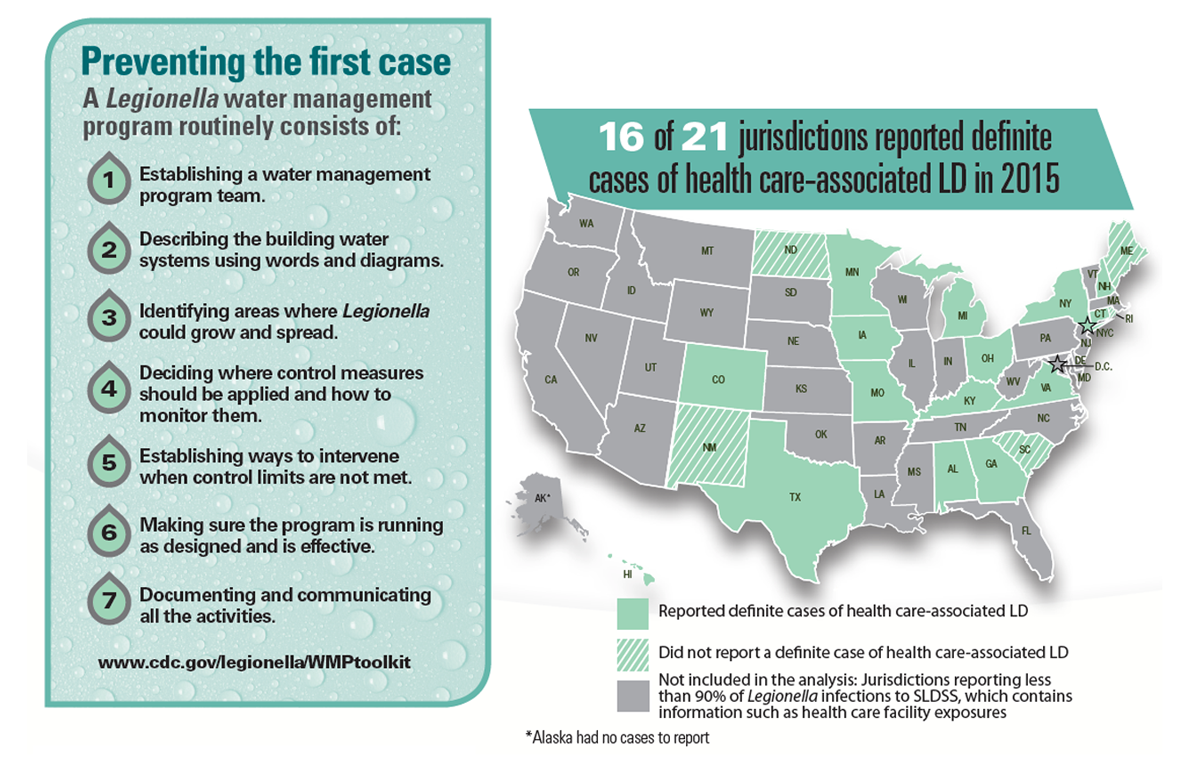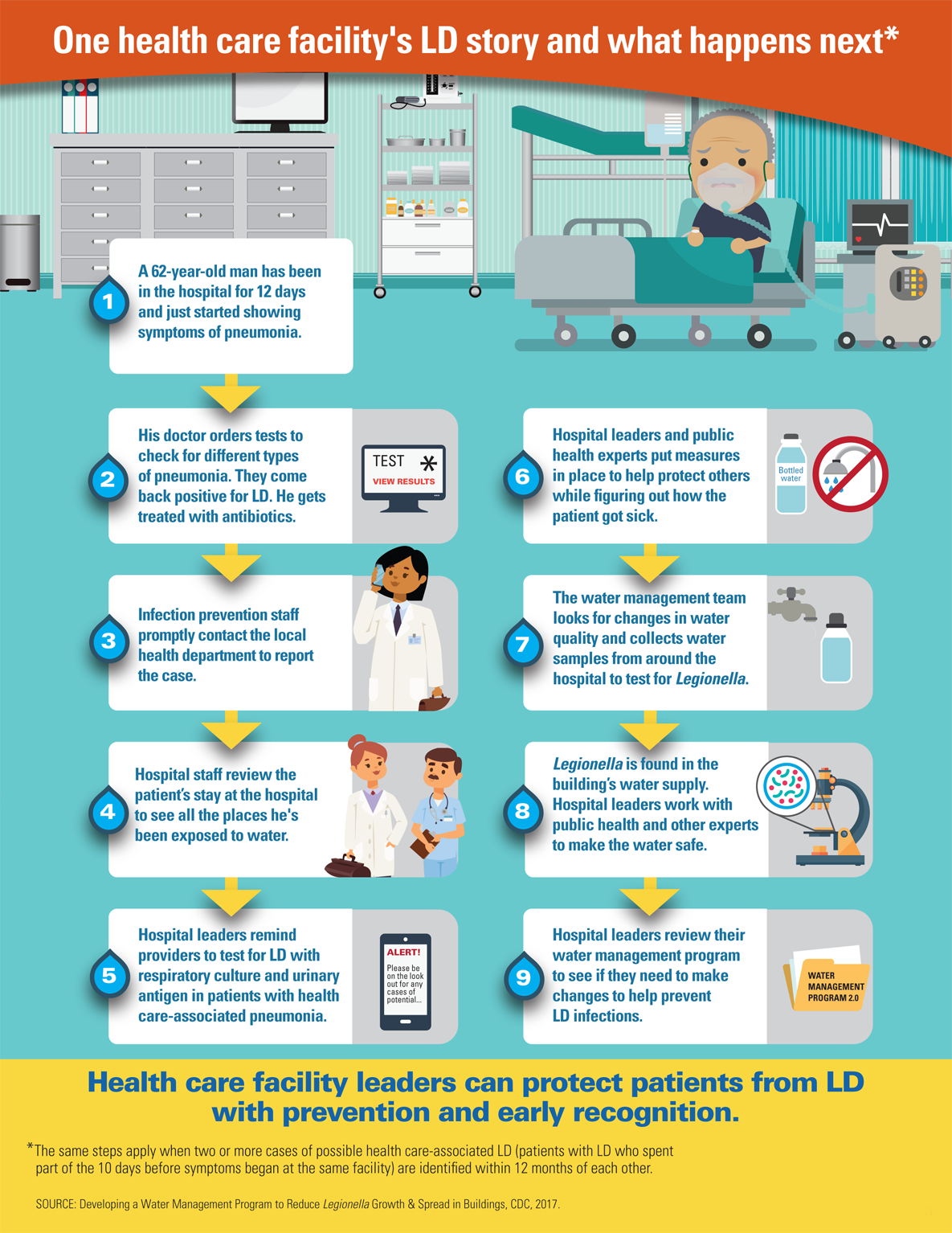Legionnaires’ Disease
What you should know

Preventing the first case
A Legionella water management program routinely consists of:
- Establishing a water management program team.
- Describing the building water systems using words and diagrams.
- Identifying areas where Legionella could grow and spread.
- Deciding where control measures should be applied and how to monitor them.
- Establishing ways to intervene when control limits are not met.
- Making sure the program is running as designed and is effective.
- Documenting and communicating all the activities.
https://www.cdc.gov/legionella/WMPtoolkit
SOURCE: ASHRAE 188: Legionellosis: Risk Management for Building Water Systems June 26, 2015
16 of 21 jurisdictions reported definite cases of health care-associated LD in 2015
The following jurisdictions reported definite cases of health care-associated Legionnaires’ disease: Alabama, Colorado, Connecticut, Georgia, Hawaii, Iowa, Kentucky, Michigan, Minnesota, Missouri, New Hampshire, New York, New York City, Ohio, Texas, and Virginia.
The following jurisdictions did not report a definite case of health care-associated Legionnaires’ disease: Maine, New Mexico, North Dakota, Rhode Island, and South Carolina.
The following jurisdictions are not included in the analysis: Alaska, Arizona, Arkansas, California, Delaware, District of Columbia, Florida, Idaho, Illinois, Indiana, Kansas, Louisiana, Maryland, Massachusetts, Mississippi, Montana, Nebraska, New Jersey, Nevada, North Carolina, Oklahoma, Oregon, Pennsylvania, South Dakota, Tennessee, Utah, Vermont, Washington, West Virginia, Wisconsin, and Wyoming. These jurisdictions reported less than 90% of Legionella infections to SLDSS, which contains information such as health care facility exposures.
*Alaska had no cases to report
SOURCE: Supplemental Legionnaires’ Disease Surveillance System (SLDSS), CDC, 2015.

Cartoon graphic of an elderly male patient hooked up to a ventilator in the bed at a health care facility with a monitor next to him. A TV rests on a chest in the room. There is a trash can in the floor and a cart with supplies on it.
One health care facility’s LD story and what happens next*
- A 62-year-old man has been in the hospital for 12 days and just started showing symptoms of pneumonia.
- His doctor orders tests to check for different types of pneumonia. They come back positive for LD. He gets treated with antibiotics.The image is of a screen that says, “Test * VIEW RESULTS.”
- Infection prevention staff promptly contact the local health department to report the case. The image is of a female doctor.
- Hospital staff review the patient’s stay at the hospital to see all the places he’s been exposed to water. The image is of two hospital staff.
- Hospital leaders remind providers to test for LD with respiratory culture and urinary antigen in patients with health care-associated pneumonia. The image is of the screen of a cell phone that says, “ALERT! Please be on the look out for any cases of potential…”
- Hospital leaders and public health experts put measures in place to help protect others while figuring out how the patient got sick. The images are of bottled water and a shower head.
- The water management team looks for changes in water quality and collects water samples from around the hospital to test for Legionella. The images are of a faucet and a bottle of water.
- Legionella is found in the building’s water supply. Hospital leaders work with public health and other experts to make the water safe. A microscope is shown with an image of magnified bacteria.
- Hospital leaders review their water management program to see if they need to make changes to help prevent future LD infections. The folder says, “WATER MANAGEMENT PROGRAM 2.0”.
Health care facility leaders can protect patients from LD with prevention and early recognition.
* The same steps apply when two or more cases of possible health care-associated LD (patients with LD who spent part of the 10 days before symptoms began at the same facility) are identified within 12 months of each other.
SOURCE: Developing a Water Management Program to Reduce Legionella Growth & Spread in Buildings, CDC, 2017.
- Page last reviewed: June 6, 2017
- Page last updated: June 6, 2017
- Content source:


 ShareCompartir
ShareCompartir